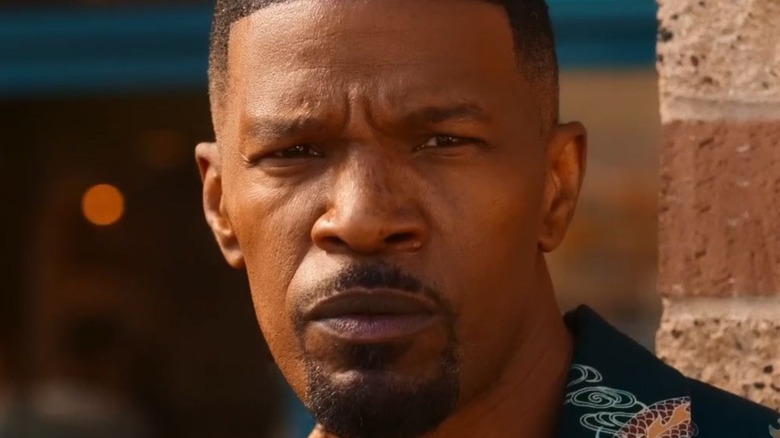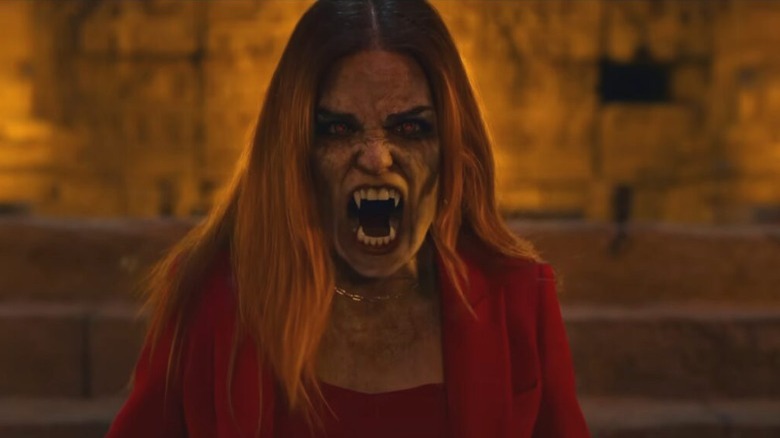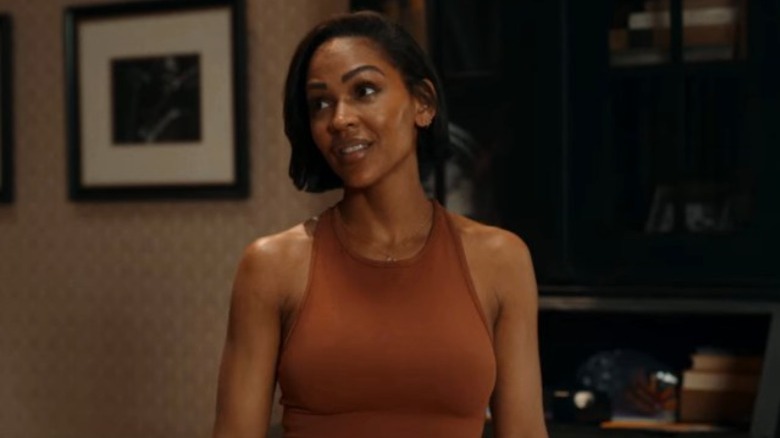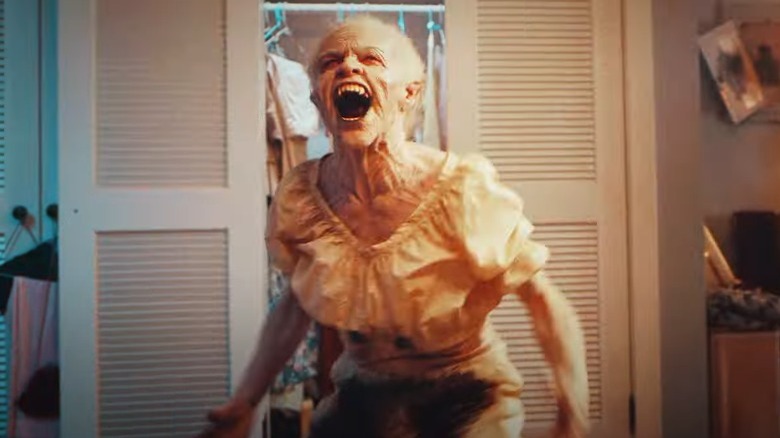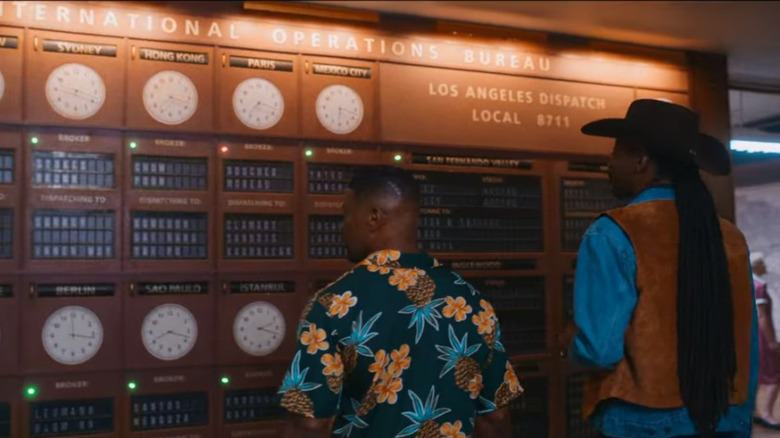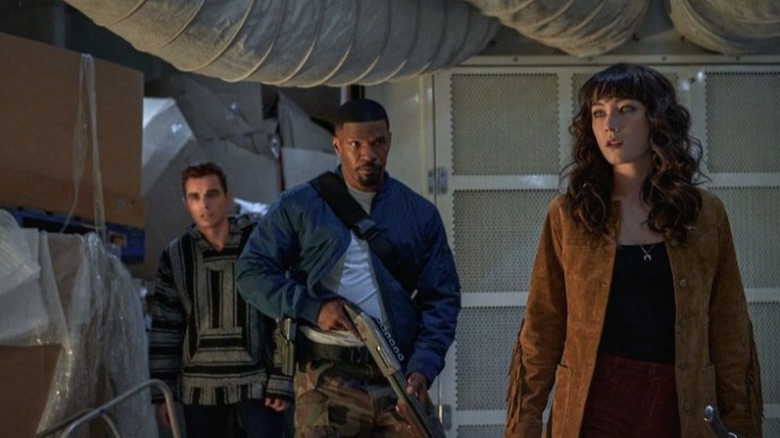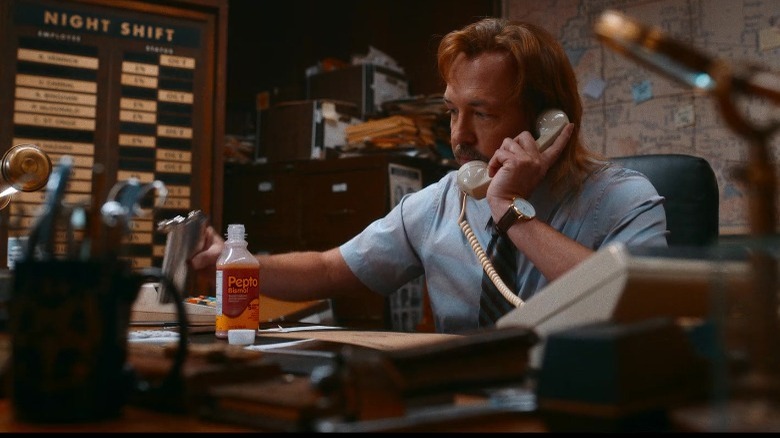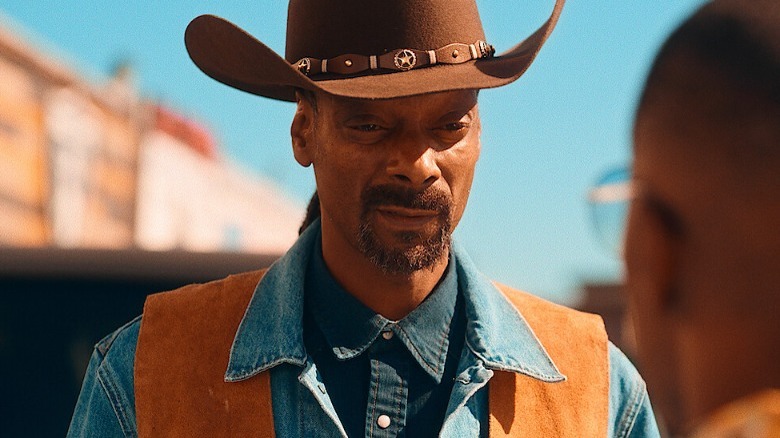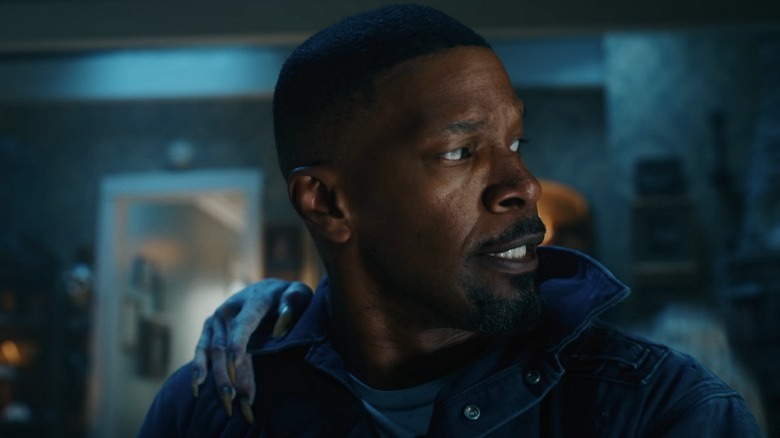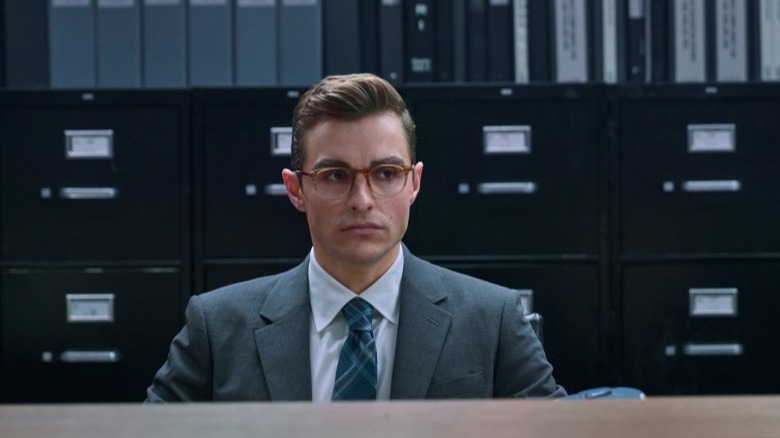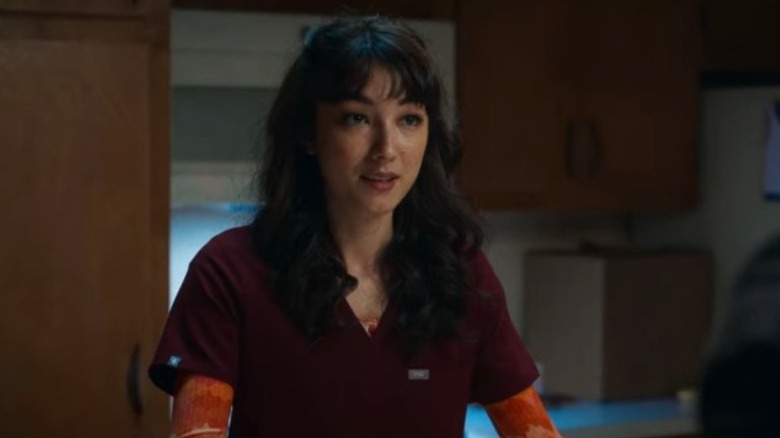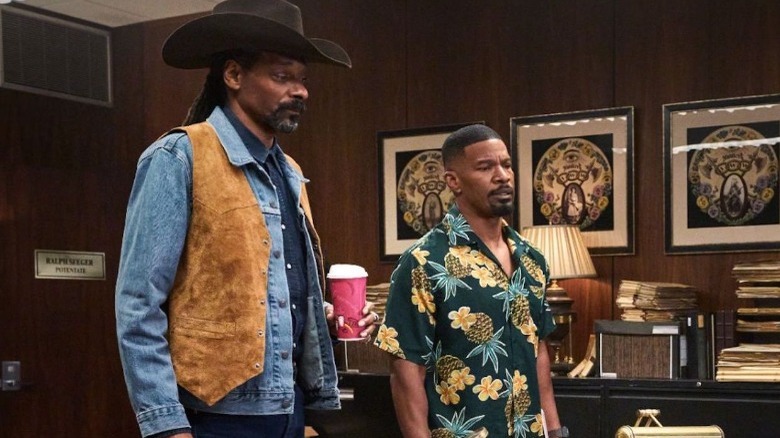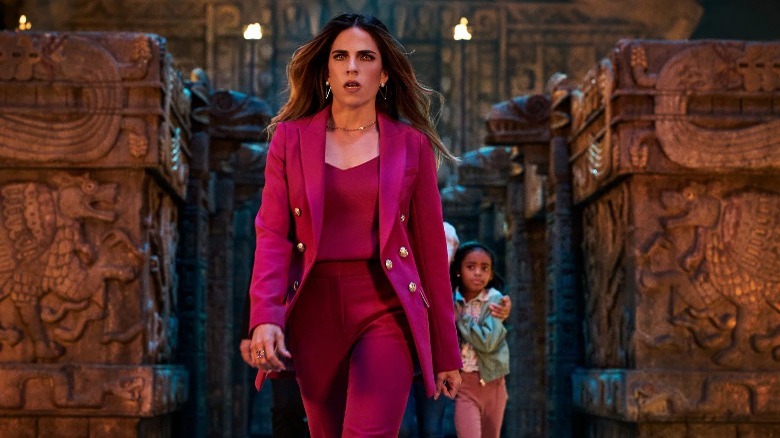The Ending Of Day Shift Explained
Netflix's new release "Day Shift" is a new, sunny kind of vampire movie. Set in the San Fernando Valley and (for various plot reasons) taking place largely during daylight, it's a casual and breezy affair that just sort of aimlessly kills time between visceral, intense action sequences. While that makes perfect sense for the directorial debut of long-time stuntman J. J. Perry, "Day Shift" is guilty of perhaps being too casual in its approach to its own plot and skimpy on explanations of the particulars of its vampire mythology. While it is refreshing to see a vampire action movie that boasts such a broad sense of humor instead of the usual gothic, self-serious tone, "Day Shift" does need a little more to connect the dots between all the bloody beheadings.
Jamie Foxx stars in the film as Bud Jablonski, a vampire hunter masquerading as a pool cleaner who is also struggling to provide for his family. He lives in a world where vampire hunting is both a hardscrabble lifestyle and also supports an entire underground economy. The first vampire he meets is nearly impossible to kill, but at later points he and fellow hunter Big J (Snoop Dogg, more or less playing himself) kill them in large groups almost effortlessly. There are several species of vampires but we hardly learn the actual differences, and some sort of real estate- and sunscreen-based evil plot that the villain never takes the time to really elucidate. For all those wondering, here is the ending of "Day Shift" explained.
Audrey's diabolical plan
Although the majority of vampires in "Day Shift" we meet are evil, the film's main villain is the aptly named Audrey San Fernando (Karla Souza). More than a century old, she's posing as a realtor with a master plan to buy up all of the San Fernando Valley and make it into a new paradise for her kind. She claims that vampires were once worshipped as gods in ancient times and wants to restore that interspecies pecking order. Although she's interested in vampire supremacy, this doesn't stop her from turning on other vampires that stand in the way, as we first meet her burying another vampire alive in cement for resisting selling her his property.
Her plan is two-pronged — or two-fanged if you'll forgive the obvious pun. In addition to her "Chinatown" like snapping up of real estate, she's somehow convinced the multiple species of vampire that exist in the world of "Day Shift" to all live together in massive hives, like the one that Bud and the Nazarian brothers shoot up halfway through the movie. Apparently cohabitating had never occurred to vampires before; they've just been strict individualists for eons. Combine this with a new, extra-strong type of sunscreen, and vampires will rule the valley at all hours. This plan is (probably) in shambles after Bud takes Audrey's head off at the end of the movie, of course.
No more lies
Although Bud's desire to keep his family together is the primary emotional motivation for the entire movie, we don't get a lot of details on his relationship with ex-wife Jocelyn (Megan Goode), or an indication of why she's so ready to go nuclear and take their daughter Paige all the way across the country to Florida. Private school tuition is indeed expensive, but surely there's a middle ground somewhere? Once Audrey kidnaps Jocelyn and Paige, the last third of the movie raises the stakes of the chase.
In the end, after being nothing but a source of frustrated energy when she thought Bud was just an unreliable pool cleaner, Jocelyn has rapidly changed into an upbeat and supportive co-parent. Despite learning not only that vampires exist in the world, but that her ex-husband has been a vampire hunter for years and indirectly nearly gotten her and Paige killed, she's seemingly accepted it and is even halfway to taking Bud back, just like that. Perhaps in a sequel, if there is one, we'll learn it's not that simple and this was just her was of dealing with the shock.
Gotta catch em all
As helpfully recited by Bud's union rep Seth (Dave Franco), there are five species of vampire in the world of "Day Shift": Southern, Eastern, Spider, Uber, and Juvenile. This is both more elaborate and more casually tossed around than most movie vampire mythology. We learn a bit about Juveniles when Bud and Seth follow the animal shelter employee (likely a Juvenile vampire's familiar) to the bowling alley: since "juvies" can't process human blood as they're halfway formed and more zombie-like, they prey on small animals like rodents or cats to survive.
The other key difference between vampire species is that Uber vampires can regenerate basically anything, and even survive decapitation if they're not also impaled with wood. This is why the elderly vampire Bud kills at the beginning proves so difficult, and also why Seth survives Bud cutting his head off when he's just woken up as a vampire. Both of them were "turned" by Uber vampire Audrey, who Bud luckily uses the same combination of wood and silver to take down in the end.
The Vampire Tooth Stock Exchange
The most interesting and unique part of "Day Shift" is the vampire hunters' union, and the market for vampire fangs that Bud relies on to earn money for his family — ironically he needs to de-fang several vampires to pay for his daughter's braces. The union pays premium prices for vampire fangs, which also go for decent money on the black market at a pawn shop, but it's never explained what makes them valuable. Do they contain properties that are useful somehow, or are they just a weird trophy like elephant horns or antlers?
When Bud and Big J walk through the union office, we get glimpses of international displays of every major vampire "market," and see large amounts of money being flashed at the trading counter. Vampire hunting and vampire teeth are obviously a large and bustling international economy. Perhaps a potential sequel will explore what powers this strange reality: perhaps a wealthy and unseen individual or institution is financing the entire market, incentivizing vampire hunting for the greater good by creating an artificial value for their teeth.
They're the good vampires
Three-fourths of the way through "Day Shift," after operating on pretty standard "humans vs. vampires," good and evil logic, the movie becomes much less black and white as suddenly a couple of vampires are on Bud's side. Seth, despite an initial uncontrollable lunge at Bud right after he was turned, is determined to help Bud get his family back and take revenge on Audrey for making him a vampire. And we also learn that Heather, Bud's new neighbor that Audrey sent to spy on him, has only been reluctantly following the orders of her "maker" and is willing to turn on Audrey as well.
After the successful rescue, Bud tells his daughter "they're the good vampires," but nobody brings up any larger implications to this. Vampires can be good? How does Bud know that all the vampires he kills are bad? Does the union have a way to tell the difference? Are all the other vampires we've seen just as capable of deciding to be good or bad as Seth and Heather, or is this a particular trait of Uber vampires? Do vampires have human rights in the world of "Day Shift"? When you think about it, most of the vampires we've even seen Bud kill were just minding their business when he broke in, playing video games or eating cats. It's possible that he's actually the real villain of the movie, much like Richard Matheson's story "I Am Legend."
An anti-worker union
"Day Shift" is essentially just a buddy cop movie, with Bud the renegade that breaks all the rules and Seth essentially his by-the-book rookie partner. The vindictive and irritable Ralph Seeger (Eric Lange) may as well demand Bud's badge and gun on his desk, like an angry police sergeant. The specifics of the vampire hunters' union, at least as they apply to Bud in this story, are all just about whether or not he's abiding by the rules and bylaws related to his conduct on the job.
It makes you wonder why they called it a union in the first place. Other than being a way to get the best prices for vampire fangs (after dues and various other fees are deducted), at no point does it seem like an organization that's concerned with workers rights the way unions protect them in reality — apart from one throwaway line about setting Bud up for some access to health care.
How did Big J survive?
In the final scene of "Day Shift," we learn that Snoop Dogg's delightfully entertaining Big John has miraculously survived his apparent sacrifice in Audrey's temple. In a movie that doesn't take itself too seriously, Snoop has by far the most fun with his supporting role, and Big J's survival is great news for a potential sequel. But how did he pull it off? When last seen, he was seconds away from detonating an explosive vest as several vampires ran straight for him, and was also nursing a vampire bite to the neck.
There are basically two possibilities. The first is that John's explosive vest, even though it released a flash of blue light in the distance from Bud's vantage point, was actually some sort of garlic bomb that only affected vampires and left him unharmed, like many of the other targeted weapons introduced in "Day Shift." The second is that when we see him at the end, he's turned into a vampire himself, and managed to drink some vampire blood in addition to being bitten (a part of the process for turning that Seth mentions earlier). As he says when he climbs out of the sewers, that's what he loves about L.A., "all the d*** vampires."
A different job
The biggest unknown in "Day Shift" among many is perhaps Bud's backstory, and his reasons for vampire hunting in the first place. When we meet his character, he's lost his marriage and is on the verge of his daughter being moved across the country, with his lack of income and general unreliability the primary cause. He knows for a fact there is a vast network of vampire hunters dedicated to hunting them down, so why is it so important that he do it himself? "Day Shift" asks us to accept this without explanation, but also to be compelled about his family struggles as if these things are equally weighted.
During the all-out fight with Audrey at the end of movie, he even brings this up himself and mutters "I gotta get a different job," but when things work out for him it doesn't seem like that's his intention, especially since he's still in the good graces of the union thanks to Seth. But in the several years before the events of "Day Shift," its unknown what makes Bud stick with vampire hunting. At a certain point you'd think actually cleaning pools would be a more regular paycheck, in addition to being much less dangerous and harrowing.
Seth's future as a vampire
The elephant in the room as "Day Shift" winds up is Seth's future. He seems convinced that he can return to his job, despite now being a vampire and working for an international union of vampire hunters. This seems like an obvious recipe for disaster, despite his enthusiasm for getting bloody revenge on his coworker Carol for constantly eating his yogurt. It seems like his detail-oriented boss Seeger would eventually notice Seth avoiding sunlight and hiding his teeth from view, especially now that he's in the doghouse for defending Bud as staying within union protocol.
Much like Bud, Seth's future is cloudy to us because we never get a sense of his motivation. How did he wind up at the union in the first place? As a meek and skittish person, it seems strange to get involved in the vampire hunting industry, even as a suit-wearing factotum. As a vampire, Seth has proved he's finally ready for field work and grown a little bit, but he seems like he's still in denial that his life is fundamentally over now that he's turned.
How did Heather betray Bud?
After Audrey tortures Troy (Peter Stormare) at his pawn shop and learns Bud's identity as her daughter's killer, it isn't long before Heather (Natasha Liu Bordizzo) arrives as Bud's new next-door neighbor at his apartment complex. She turns out to have been a plant ordered by Audrey to spy on Bud and gather information and presumably has something to do with how Audrey stalks Bud to the party he and his daughter attend, and then has already broken into Jocelyn's home when he gets there.
We never get a scene, however, of Heather actually doing any recon on Bud other than making casual small talk one time. It feels like "Day Shift" has a scene that it cut for time of Heather either breaking into his apartment (which would mean vampires don't have the "invite them in" problem in this world), or at least spending a little more intimate time with Bud as a fake friend. With hardly any screen time, her betrayal of Bud doesn't carry much weight, nor does her change of undead heart in turning on Audrey and helping Bud in the finale really make much sense.
The day shift versus the night shift
The movie gets its very title from the idea that vampire hunting is scheduled in two different shifts, day and night, at the union. Apparently, you're shifted to one or the other to do your vampire hunting, but the night shift is much preferable since it sees a lot more vampire activity. It seems like Bud's whole modus operandi, however, is to operate during the day when daylight-fearing vampires are actually weaker and at least confined to one location.
When they prepare for the big final assault on Audrey's complex, in addition to being outnumbered Seth points out that as it's nighttime, it's even more dangerous. So it's not really clear why the riskier shift would be the more desirable one, but "Day Shift" isn't terribly interested in the psychology of vampire hunters. Ultimately, it seems like they all work freelance anyway, and just bring back fangs to actually get paid instead of punching a clock, so the day and night shifts are kind of irrelevant as we never see anyone punch a clock.
Why did Audrey have vampire-killing bullets?
One small detail that flies by in the assault on Audrey's compound at the movie's end is that Seth gets hit by a bullet that "actually hurts." This means that in addition to regular weapons meant for humans, Audrey has also stock-piled some amount of silver bullets meant to be shot at other vampires. Since her whole deal is building a vampire utopia and putting humanity back in its secondary place, why would she need weapons like this at all?
It's likely that Audrey, who we know is willing to step on other vampires in her way, was planning to go to war with "El Jefe," the legendary 700-year-old vampire that is mentioned as the true kingpin of Los Angeles, after she takes over the Valley. Though Bud scoffs at the idea of El Jefe as an urban legend, it's likely that we've already heard of the villain that will haunt him in a "Day Shift" sequel, should there be one.
